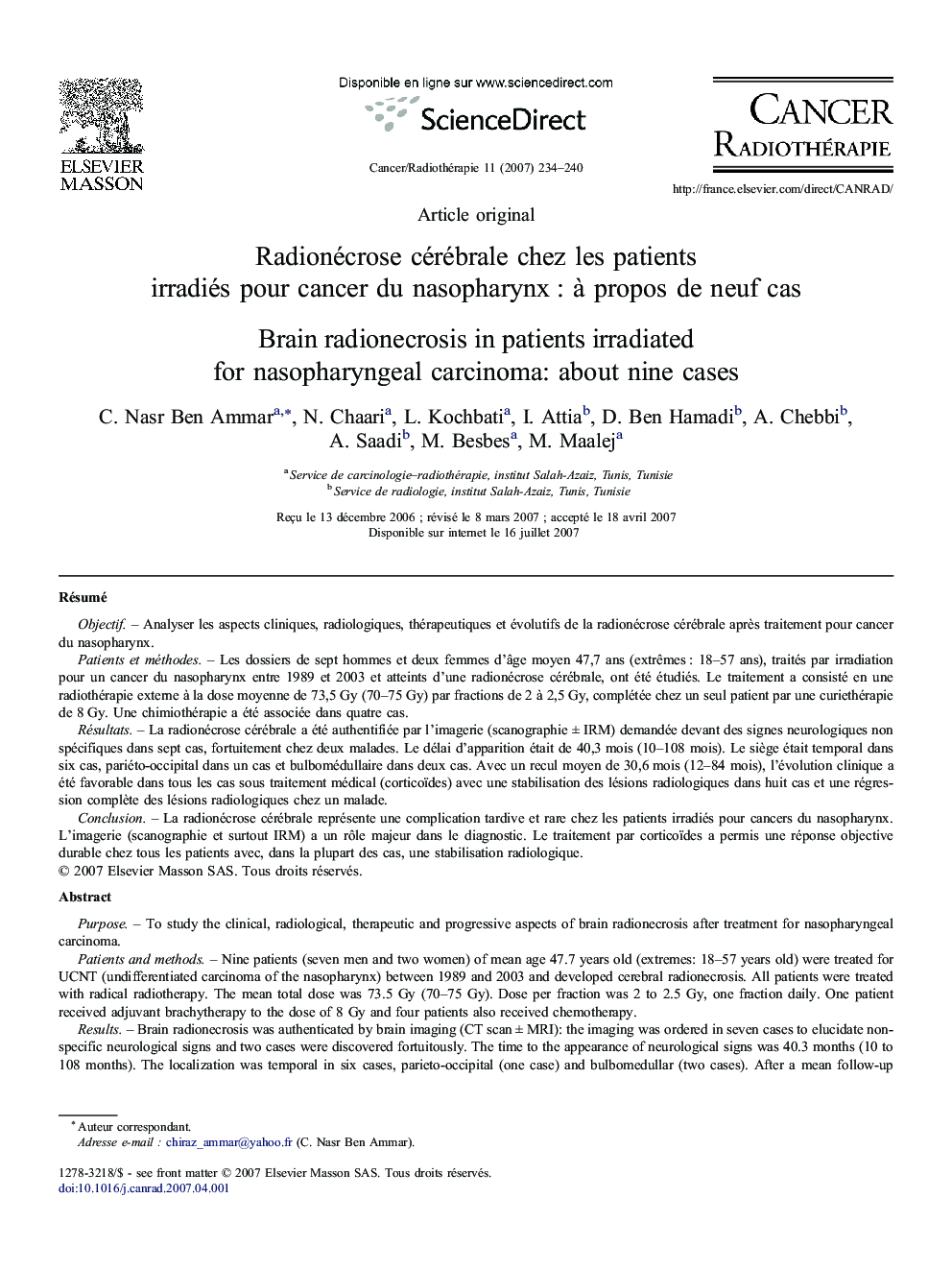| کد مقاله | کد نشریه | سال انتشار | مقاله انگلیسی | نسخه تمام متن |
|---|---|---|---|---|
| 2118945 | 1085262 | 2007 | 7 صفحه PDF | دانلود رایگان |

RésuméObjectifAnalyser les aspects cliniques, radiologiques, thérapeutiques et évolutifs de la radionécrose cérébrale après traitement pour cancer du nasopharynx.Patients et méthodesLes dossiers de sept hommes et deux femmes d’âge moyen 47,7 ans (extrêmes : 18–57 ans), traités par irradiation pour un cancer du nasopharynx entre 1989 et 2003 et atteints d’une radionécrose cérébrale, ont été étudiés. Le traitement a consisté en une radiothérapie externe à la dose moyenne de 73,5 Gy (70–75 Gy) par fractions de 2 à 2,5 Gy, complétée chez un seul patient par une curiethérapie de 8 Gy. Une chimiothérapie a été associée dans quatre cas.RésultatsLa radionécrose cérébrale a été authentifiée par l’imagerie (scanographie ± IRM) demandée devant des signes neurologiques non spécifiques dans sept cas, fortuitement chez deux malades. Le délai d’apparition était de 40,3 mois (10–108 mois). Le siège était temporal dans six cas, pariéto-occipital dans un cas et bulbomédullaire dans deux cas. Avec un recul moyen de 30,6 mois (12–84 mois), l’évolution clinique a été favorable dans tous les cas sous traitement médical (corticoïdes) avec une stabilisation des lésions radiologiques dans huit cas et une régression complète des lésions radiologiques chez un malade.ConclusionLa radionécrose cérébrale représente une complication tardive et rare chez les patients irradiés pour cancers du nasopharynx. L’imagerie (scanographie et surtout IRM) a un rôle majeur dans le diagnostic. Le traitement par corticoïdes a permis une réponse objective durable chez tous les patients avec, dans la plupart des cas, une stabilisation radiologique.
PurposeTo study the clinical, radiological, therapeutic and progressive aspects of brain radionecrosis after treatment for nasopharyngeal carcinoma.Patients and methodsNine patients (seven men and two women) of mean age 47.7 years old (extremes: 18–57 years old) were treated for UCNT (undifferentiated carcinoma of the nasopharynx) between 1989 and 2003 and developed cerebral radionecrosis. All patients were treated with radical radiotherapy. The mean total dose was 73.5 Gy (70–75 Gy). Dose per fraction was 2 to 2.5 Gy, one fraction daily. One patient received adjuvant brachytherapy to the dose of 8 Gy and four patients also received chemotherapy.ResultsBrain radionecrosis was authenticated by brain imaging (CT scan ± MRI): the imaging was ordered in seven cases to elucidate non-specific neurological signs and two cases were discovered fortuitously. The time to the appearance of neurological signs was 40.3 months (10 to 108 months). The localization was temporal in six cases, parieto-occipital (one case) and bulbomedullar (two cases). After a mean follow-up period of 30.6 months (12–84 months), clinical outcomes were favorable in all cases receiving medical treatment (corticoids), with a stabilization of the radiological lesions in eight cases and complete radiological regression in one patient.ConclusionBrain radionecrosis is a late complication rarely occurring in patients irradiated for UCNT. Imaging techniques (CT scan but more so MRI) play a major role in the diagnosis. Corticotherapy resulted in a durable objective response in all patients and, in most cases, resulted in radiological stabilization.
Journal: Cancer/Radiothérapie - Volume 11, Issue 5, September 2007, Pages 234–240